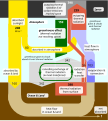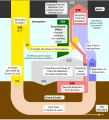File:Earth Energy Budget with GHE.svg

原始檔案 (SVG 檔案,表面大小:701 × 913 像素,檔案大小:32 KB)
摘要
| 描述Earth Energy Budget with GHE.svg |
English: This diagram shows energy flows to and from Earth, identifying the greenhouse effect as it is quantitatively measured, and distinguishing heat flows from energy flows that don't transfer heat (or net energy).
Overview Energy flows into the system as absorbed sunlight, and leaves as infrared thermal radiation emitted to space. If energy arrives faster than it leaves, energy accumulates, increasing temperatures and the rate at which energy leaves. Any imbalance between the rates of energy arriving and leaving naturally causes the temperature to adjust to equalize the rates of energy arriving and leaving. Greenhouse gases interfere with energy leaving. They exchange thermal radiation with the surface, cancelling flows of radiative energy that would otherwise head towards space. And, while greenhouse gases emit thermal radiation that reaches space, they do so at a high altitude, where temperatures and thermal radiation emission rates are low. Overall, greenhouse gases inhibit radiative cooling of the planet. To compensate for greenhouse gases making it difficult for thermal radiation to reach space, the surface temperature rises, until enough radiation reaches space to shed heat at the same rate that it arrives from the Sun. It is the process of cooling being inhibited and temperature rising to restore balance that leads to greenhouse gases causing warming. The size of this effect, called the greenhouse effect, is quantified by measuring as how much more thermal radiation leaves the surface than reaches space. At present, 40% (or 159 W/m2) less thermal radiation reaches space than is emitted by the surface. Notes
References Data is taken from the energy budget diagram in the IPCC 2021 AR6 WG1 report p. 934, and based on data published in 2015. The technical definition of the GHE used is from p. 968 of that same report, and the associated references. There is a precedent for considering heat flows instead of just energy flows in the NASA diagrams on NASA Earth Observatory's page Climate and Earth’s Energy Budget which includes both heat flow diagrams and energy flow diagrams. The current diagram integrates the energy flow diagrams and heat flow diagrams from that page into a single diagram. Answers to questions: Q: Does 56 W/m2 include both radiation going straight to space and radiation absorbed by the atmosphere? A: Yes. Some thermal radiation emitted by the surface passes through the "atmospheric window" (a range of wavelengths in which the atmosphere is transparent) sending thermal energy straight to space. Other radiation transfers heat to the atmosphere. The data source used for this diagram doesn't indicate the split between these two processes, which is why the diagram only indicates the total radiative heat transfer away from the surface (56 W/m2). Some other sources estimate the flow through the atmospheric window as 40 W/m2, which suggests the radiation heat transfer to the atmosphere might be about 16 W/m2. However, the two data sources offer values that differ for some quantities, so it's not necessarily safe to combine data from the two sources. Q: What is meant by "net absorbed" (1 W/m2)? A: This value, sometimes labelled Earth's radiative "energy imbalance", is the rate at which energy is flowing into Earth's oceans, atmosphere, and land, without any corresponding outflow. This indicates that the system is not in steady-state, but is instead warming in an ongoing fashion. Typically this involves increasing the temperature of ocean water or melting ice. Q: Is the "net absorbed" value 1 W/m2 how the greenhouse effect causes warming? A: It's important to distinguish dynamic warming (the temperature getting warmer over time) from steady-state "warming" (things being warmer than they would be otherwise). The energy imbalance or "Net absorbed" value is what is responsible for ongoing "dynamic warming." It's non-zero because the GHE is increasing. However, even if the "Net Absorbed" value was zero, the GHE would still be causing the Earth to be warmer than it would otherwise be. You can tell this, because if all surface radiation reached space (i.e., if there was no GHE), then Earth would cool at a rate of 398 W/m2; there would be a huge energy imbalance, and Earth would rapidly get colder until the surface temperature got low enough for outgoing thermal radiation to match the rate at which energy is being absorbed from the Sun. Note that the rate of thermal radiation being emitted from the surface is a direct indicator of surface temperature. Q: What's this talk of upwards and downwards radiation flows effectively cancelling one another out and not resulting in any heat transfer? A: The thermodynamic definition of "heat" relates to the net energy transfer, not to individual radiative energy flows. If you look at the formula for radiative heat transfer, you'll see that the formula involves subtraction the power of radiation in one direction from the power of radiation in the other direction. So, to the extent that there are equal radiation power flows in each direction, those equal flows do not add to the radiative heat transfer rate. This is why the numbers in the heat flow and energy flow diagrams on the NASA webpage Climate and Earth’s Energy Budget are different. The heat flow numbers are what you are left with after you cancel out opposing radiation energy flows. Q: I've seen the 342 W/m2 downward thermal radiation flux described as being the greenhouse effect. What's the difference between that and the 159 W/m2 that this diagram labels as the greenhouse effect? A:' Both numbers reflect the influence of materials in the atmosphere than absorb longwave thermal radiation. The value 342 W/m2 is essentially the amount by which greenhouse gases and clouds reduce radiative heat loss from the surface. The value 159 W/m2 is the amount by which greenhouse gases and clouds reduce radiative heat loss from the planet as a whole. The numbers differ due to the effects of evaporation, convection, and sunlight absorption in the atmosphere. When it comes to assessing impact on the temperature of the planet, and even impact on the temperature of the surface, the reduction in planetary heat loss is the important number. It's also the number that is most commonly being referred to when scientists assign a value to the greenhouse effect. Q: Why isn't the "atmospheric heat flow" broken down into more specific types of heat flows? A: This type of diagram only addresses heat flows between the realms of space, the surface, and the atmosphere. All the heat flows with specific information associated with them are flows between two of these realms. The source material used to develop this figure doesn't provide any details concerning what happens inside the atmosphere. Most energy budget diagrams don't explicitly show the "atmospheric heat flow." This diagram makes that flow explicit to help one see that energy is being conserved. However, no details regarding the flow are available. In practice, it involves some mix of latent heat transport (water vapor movement), convection, and radiation heat transfer. Q: Why do the upward heat flows jog to the right instead of going straight up? A: Left-right positions on the diagram have no physical meaning. "Outgoing thermal radiation" flow was positioned directly above "thermal radiations from surface," to make it easy to compare these two flows, and measure the greenhouse effect as the difference between these two energy flow rates. Some flows were drawn with a "jog to the right" to allow the outgoing and surface thermal emissions to be vertically aligned visually. Q: Why does the sum of the values for "radiation heat transfer" (56 W/m2), "evaporation" (82 W/m2) and Convection" (21 W/m2) add up to match the value of the "Greenhouse Effect" (159 W/m2)? A: That is just an unfortunate numerical coincidence. Those quantities wouldn't necessarily match if something in Earth's climate changed. What is not a coincidence is that the "Greenhouse Effect" (159 W/m2) equals 398 W/m2 minus 239 W/m2, the flux of thermal radiation leaving the surface minus what reaches space. Q: If greenhouse gasses emit equally in all directions, why is 342 W/m2 emitted downward, but no equal upwards radiation flow is seen? A: There is an identical upward flow between one layer of the atmosphere and the next, as well as a similar downward flow between those layers that largely cancels out the upward flow. This repeatedly happens between successive layers of the atmosphere. However, at each stage, the radiation flows get smaller and smaller because of the decreasing air temperature. The final upward flow is 239 W/m2, as depicted. However, the diagram is only intended to detail energy flows between the three realms of space, ocean & land, and atmosphere, not to show the details of energy flows within a particular realm. That's why the details of energy flows within the atmosphere are not shown. Q: How can the surface emit 398 W/m2 of thermal radiation when the surface receives only 160 W/m2 from sunlight? A: The surface emits 398 radiative heat transfer because it has a temperature around 15℃. It doesn't require any external power source for this radiation to be emitted. Every object around you is emitting thermal radiation all the time. This doesn't violate conservation of energy because objects are receiving back comparable amounts of energy from their environment. If an object doesn't get energy back (because the environment is cold), the energy imbalance will cause the object to get colder, and it will consequently radiate less energy. There is nothing special about the Earth's surface and atmosphere thermodynamically; they obey the same laws of radiative heat transfer as everything else. |
| 日期 | |
| 來源 | 自己的作品 |
| 作者 | Rhwentworth |
授權條款
- 您可以自由:
- 分享 – 複製、發佈和傳播本作品
- 重新修改 – 創作演繹作品
- 惟需遵照下列條件:
- 姓名標示 – 您必須指名出正確的製作者,和提供授權條款的連結,以及表示是否有對內容上做出變更。您可以用任何合理的方式來行動,但不得以任何方式表明授權條款是對您許可或是由您所使用。
- 相同方式分享 – 如果您利用本素材進行再混合、轉換或創作,您必須基於如同原先的相同或兼容的條款,來分布您的貢獻成品。
說明
創作作者 Chinese (Hong Kong) (已轉換拼寫)
沒有維基數據項目的某些值
共享創意署名-相同方式共享4.0國際 Chinese (Hong Kong) (已轉換拼寫)
28 4 2023
多媒體型式 繁體中文 (已轉換拼寫)
image/svg+xml
檔案歷史
點選日期/時間以檢視該時間的檔案版本。
| 日期/時間 | 縮圖 | 尺寸 | 用戶 | 備註 | |
|---|---|---|---|---|---|
| 目前 | 2023年5月10日 (三) 00:58 |  | 701 × 913(32 KB) | Rhwentworth | Tuned some colors to improve visibility without text bubbles, changed "convection" to "thermals" |
| 2023年5月9日 (二) 06:37 |  | 700 × 913(34 KB) | Rhwentworth | Made some labels vertical, changed presentation of surface emissions | |
| 2023年5月6日 (六) 21:24 |  | 700 × 913(33 KB) | Rhwentworth | Added annotations at bottom to clarify organizational structure of diagram | |
| 2023年5月6日 (六) 05:18 |  | 700 × 846(30 KB) | Rhwentworth | Minor styling changes to lines/arrows; text re 40% changed | |
| 2023年5月6日 (六) 01:13 |  | 700 × 846(31 KB) | Rhwentworth | Added semicircles to indicate energy conservation in non-heat energy flows; other refinements | |
| 2023年5月5日 (五) 03:49 |  | 712 × 781(25 KB) | Rhwentworth | Improved styling of surface thermal radiation, added GHE percentage | |
| 2023年5月4日 (四) 00:36 |  | 712 × 781(25 KB) | Rhwentworth | Reworked image to improve clarity and presentation | |
| 2023年4月30日 (日) 01:39 |  | 757 × 843(26 KB) | Rhwentworth | Tweaked colors and enlarged fonts, to address requests | |
| 2023年4月29日 (六) 23:12 |  | 776 × 850(27 KB) | Rhwentworth | Added recirculation loop graphic, made red bolder, switched to lowercase | |
| 2023年4月29日 (六) 19:46 |  | 775 × 849(25 KB) | Rhwentworth | Added "Outgoing Thermal Radiation if all surface emissions reached space" |
檔案用途
下列頁面有用到此檔案:
全域檔案使用狀況
以下其他 wiki 使用了這個檔案:
- en-two.iwiki.icu 的使用狀況
- he.wikipedia.org 的使用狀況
- ig.wikipedia.org 的使用狀況
詮釋資料
此檔案中包含擴展的資訊。這些資訊可能是由數位相機或掃描器在建立時或數位化過程中所加入。
如果此檔案的來源檔案已被修改,一些資訊在修改後的檔案中將不能完全反映出來。
| 寬度 | 701 |
|---|---|
| 高度 | 913 |

